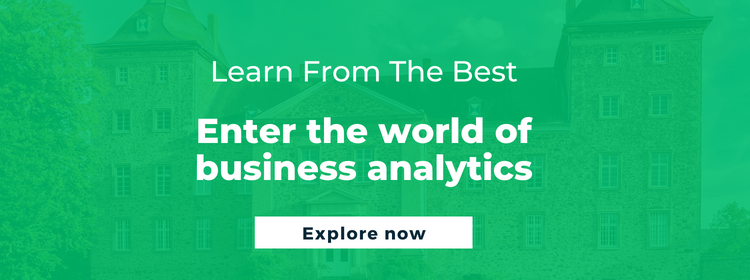What is Prescriptive Analytics and How it Helps Decision Making in Business

- What is Prescriptive Analytics?
- Why is Prescriptive Analytics Important?
- What is Prescriptive Analytics Like in Motion?
- Benefits and Drawbacks of Prescriptive Analytics
- What is Prescriptive Analytics’ Impact on Business?
- What are some Prescriptive Analytics Tools?
- Other Forms of Business Analytics
The field of big data will likely reach a valuation of over $273 billion by 2023. So it’s no wonder why industry giants like Google and Microsoft are heavily committed to not only investing in data collection but also leveraging it to boost business. Consequently, analytics, combined with artificial intelligence and machine learning, has seen tremendous growth. Owing to their efficiency in generating valuable insights and predictions from large data sets, these technologies are basically ruling the roost at this point. But what are predictions and data without actually putting them to use? Enter: prescriptive analytics. But what is prescriptive analytics? And why does it matter?
Prescriptive analytics, in the simplest terms, uses machine learning algorithms to comb through vast volumes of data and make recommendations according to specific requirements. The use of ‘if’ and ‘else’ statements allow for a deeper understanding of the target group, leading to effective marketing and, ultimately, higher revenues. However, given its rapid progress, information on prescriptive analytics is galore. In such a scenario, we must thoroughly understand the field and learn its workings from the ground up. So, let’s deep dive to know, ‘what is prescriptive analytics’.
What is Prescriptive Analytics?
Prescriptive analytics refers to harvesting data to determine the most appropriate course of action for a specific problem. In doing so, prescriptive analytics accounts for all relevant factors and offers recommendations moving forward. In this regard, it is crucial to decision-making and achieving business objectives, such as profitability, cost saving, and customer satisfaction.
The critical question that looms over decision-makers is, “What should we do next?” This is where the question of ‘what is prescriptive analytics’ comes into play. Why? It efficiently grapples with complex situations, constraints, and numerous variables to reach the optimal course of action. Due to its operational efficiency, companies use prescriptive analytics to conduct analyses, generate proprietary algorithms, and streamline several other business processes.
Related Content: What is Business Analytics?
Why is Prescriptive Analytics Important?
The strongest point in favor of prescriptive analytics is that it allows companies to reflect on past performance and chart future pathways. This is especially crucial for struggling businesses looking for a turnaround, those with low-performance metrics, and young enterprises with a few years of experience behind them. Not only does prescriptive analytics help strategize the right course of action, but it can also estimate the time frame within which one may achieve specific goals.
There are three forms of prescriptive analytics:
- Guided marketing
- Guided selling
- Guided pricing
Using a combination of artificial intelligence and machine learning eliminates the need for excessive human interaction. It adeptly prescribes the suitable target consumer base at the most advantageous time, using appropriate content. Consequently, in addition to boosting the sales of a business, it also maximizes overall profitability.
ALSO READ: Artificial Intelligence vs Machine Learning: 5 Vital Points to Know
What is Prescriptive Analytics Like in Motion?
Given its versatility and accuracy, prescriptive analytics finds its applications in a wide variety of sectors. Here are some real-time examples of prescriptive analytics in action.
Use Case 1: Investment Decisions and Venture Capital
Investment decisions have a higher chance of yielding better returns when complemented by data and algorithms. For example, an experiment cited in the Harvard Business Review tested the effectiveness of algorithmic decisions against those of an angel investor regarding startups for investment. The result highlighted the role of prescriptive analytics and experienced human expertise in flagging cognitive biases and making objective decisions.
ALSO READ: What is an Angel Investor & How to Become One?
Use Case 2: Lead Scoring in Sales
Also known as lead ranking, lead scoring is indispensable in sales and finds great support in prescriptive analytics. It refers to the process of assigning a value to the various actions within the sales funnel to rank leads according to their likelihood of converting to customers.
Use Case 3: Fraud Detection in Banking
Large volumes of data stored in bank systems make it impossible for individuals to detect fraud, potential threats, or suspicious activity. In prescriptive analytics, algorithms use historical transaction data to identify irregularities by analyzing patterns. In addition to alerting the bank, it also offers a recommendation, such as canceling a particular credit card.
Interested in protecting the cyber world? Check out: What is Cybersecurity and Why is it a Great Career Choice for You
Use Case 4: Product Development and Improvement
Prescriptive analytics inform product development to a considerable extent through market surveys, testing beta versions, collating behavioral data, and analyzing customer interactions. This data is then analyzed for trends and their effect and potential longevity. In this regard, prescriptive analytics helps identify the features to include, the ones to discard, and other features that may ensure a smooth customer experience.
You can learn more about product design and innovation as a career.
Benefits and Drawbacks of Prescriptive Analytics
As with most analytical or business tools, prescriptive analytics has upsides and downsides. Though far and in between, it is helpful to be aware of the latter to prevent incorrect applications and analyses of prescriptive analytics.
What are the Advantages of Prescriptive Analytics?
It helps prevent fraud, reduce risk, boost efficiency, expand a business’s customer base, and achieve established objectives by sifting through the chaos of variable conditions and uncertainty. When implemented correctly, it also facilitates informed decision-making, thus yielding better results as well as revenues. Furthermore, prescriptive analytics helps gauge the probability of different outcomes, allowing organizations to analyze associated risks rather than relying on instinct or averages. In this way, analytics lead to better risk mitigation as well.
What are the Drawbacks of Prescriptive Analytics?
The outcomes it generates are only as effective and valid as the input from organizations; therefore, its accuracy is variable. Moreover, it is only suitable for short-term goals and should not be used to make vital long-term decisions. 
What is Prescriptive Analytics’ Impact on Business?
Given its myriad uses in businesses, it is possible, to sum up how prescriptive analytics positively impacts organizations.
Uses of Prescriptive Analytics in Business
- Calculating past sales to compute the number of replacements
- Understanding customer behavior and their tendencies towards specific products
- Predicting equipment failure and facilitating timely maintenance
- Optimizing marketing campaigns, strategies, and operational processes
- Reducing costs effectively
- Making the process of supply chain management efficient
- Improving customer service and experience
What are some Prescriptive Analytics Tools?
Prescriptive analytics employs a combination of techniques and tools to carry out its tasks, depending on the application.
Popular Prescriptive Analytics Tools:
- H2O Driverless AI
- IBM Watson Studio
- Microsoft Azure Machine Learning
- RapidMiner Studio
- SAP Predictive Analytics
- SAS
Other Forms of Business Analytics
In addition to prescriptive analytics, the field comprises two other varieties of analytics, namely, predictive analytics and descriptive analytics. Predictive analytics makes future predictions by analyzing historical data through data mining techniques, statistical modeling, and ML. Hence, it is closely associated with big data and data science.
On the other hand, descriptive analytics uses data mining and aggregation to analyze historical data and represent past occurrences. Visual tools, such as graphs and pie charts, are the primary apparatus to generate insights.
In this day and age, all businesses, from established industry giants to young startups, strive to incorporate prescriptive analytics into their operations to improve efficiency. It’s not merely a numbers game, however. Along with predictive and descriptive analytics, prescriptive analytics offers a holistic view of the customer base and helps businesses measure the pulse of the market. And while science and technology continue to make great strides, it is universally acknowledged that truly understanding the human psyche, as analytics does, will always remain a force to reckon with.
Learn more about our online business analytics courses.
By Deyasini Chatterjee
Write to us at content@emeritus.org





